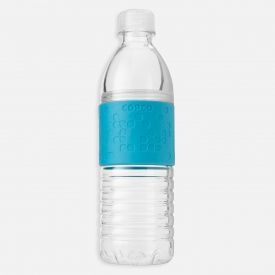Today is the first day in a ban on on-campus sales of bottled water at the University of Vermont.
When students at the University of Vermont resume classes on the snow-covered Burlington campus Monday, something will be missing: bottled water. UVM is the latest university to ban on-campus sales of bottled water.
At UVM, students can get water for their reusable bottles at specially designed campus fill-up locations. The ban was the result of a campaign started by former student Mikayla McDonald to not only reduce waste but to protect our natural resources:
“Bottled water is a symbol of our culture’s obsession with commodifying things that should be public trust resources,” she says.
(The web site Ban the Bottle has more information about bans that are in effect and planned).
One unintentional landfill created by plastic dumping is the Great Pacific Garbage Patch:
The Great Pacific Garbage Patch, also described as the Pacific Trash Vortex, is a gyre of marine litter in the central North Pacific Ocean located roughly between 135°W to 155°W and 35°N and 42°N. The patch extends over an indeterminate area, with estimates ranging very widely depending on the degree of plastic concentration used to define the affected area.
The Patch is characterized by exceptionally high concentrations of pelagic plastics, chemical sludge, and other debris that have been trapped by the currents of the North Pacific Gyre.
According to an article from the University of Melbourne, 90% of the debris is plastic:
There are five major gyres in the Indian, Atlantic and Pacific oceans, each with their own floating mats of rubbish, but it is expected that many more of these litter flotillas occur in smaller current systems across the world.
● At least 80% of this rubbish originates on land, washing out to sea via stormwater drains or from landfill located near the sea. The rest is discarded from ships and oil platforms.
● 90% of the debris is plastic.American marine and atmospheric scientists predicted the presence of these swirling vortexes of rubbish in 1988. The Great Pacific Garbage Patch was discovered in 1997 by oceanographer Captain Charles Moore, who came across by accident it while travelling home from a TransPacific yacht race. Moore remarked that he sailed through the floating rubbish for more than a week.
In a not-at-all-unexpected development, some people see bans on plastic bottles as a direct assault on their liberties (“Patrick Henry!!!1!!”). Regarding a ban being promoted for Concord MA:
The ban is the result of the efforts of Jean Hill, an 85-year-old Concord grandmother who took up the campaign to ban plastic water bottles after hearing of “floating islands of plastic as big as the United States” in the Pacific Ocean.[…]
Truth be told, Hill sounds more like the British, telling us what to drink — and what to drink it out of. She was finally able to vanquish the enemy — the dreaded plastic bottle — at Town Meeting after twice seeing it go down to defeat.
“People should have the freedom to buy a legal product in the town they live in,” group member Robin Garrison, has been quoted as saying.
Patrick Henry couldn’t have said it better.
(I hope that is snark … but I fear that it is not).
Here is what I use, purchased for $9 at my local Shopko:
● Single wall, BPA-free cold beverage bottle
● Leak-proof sealing lid
● Twist body to add ice cubs, lemons or limes
● Soft grip body
● Trendy colored grip
● 16.9-oz. capacity
BPA-free? Check.
Leak-proof? Check.
Comfortable grip? Check.
Blue? Check.
Trendy? Checkity check check check.
And for the record, destroying our common planet is NOT your unalienable right, Mr. GiveMePlasticBottlesOrGiveMeDeath.
It is actually our moral obligation to protect the environment and give future generations a safe and healthy place to live.

28 comments